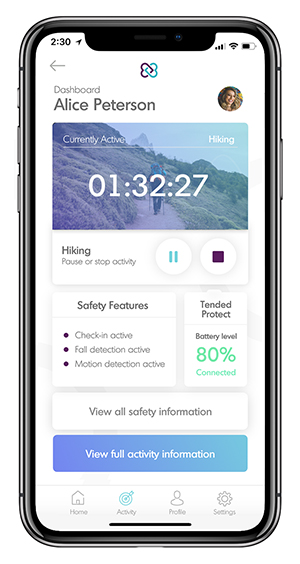A wearable device that uses artificial intelligence (AI) to detect when a lone worker has had an accident then automatically alerts emergency services is being trialled by a major UK builders’ merchant and a housebuilder.
The brainchild of tech entrepreneur Leo Scott Smith, Tended Protect is an electronic wristband that connects to a smartphone via Bluetooth and uses of a combination of sophisticated algorithms and embedded motion sensors to detect if the user is in trouble.
Failure by the user to respond to a “safety check” triggers an alert that’s sent to a list of emergency contacts along with the GPS location, health data and activity information, and the option to call the emergency services.
The standalone device is available for pre-order and Tended is working with eight key firms, including a large builders’ merchant and a housebuilder, which cannot be named for confidentiality reasons, to develop a commercial platform that will provide custom solutions designed to improve workforce safety, security and efficiency.
Scott Smith told BIM+: “The builders’ merchant wants to protect its lone workers in potentially risky or dangerous situations, but also to develop new applications, such as the ability to geosense when staff arrive on site, or a designated area of the site, and automatically remind them to wear appropriate PPE with a buzz and a message on their smartphone.”

Tended Protect provides real-time accident detection
Scott Smith founded the start-up after a personal experience in Nepal during the 2015 earthquakes, where he was confronted by aftershocks, landslides, and even an ambush. At the same time, his mother was alone at home renovating the house when she fell from a ladder.
“Although she wasn’t seriously injured it could have been a lot worse, I wanted to find a solution to these problems,” said Scott Smith. “Devices available on the market able to monitor personal safety were not very effective. There were either basic panic buttons, used by elderly people or women in vulnerable situations, or at the other end of the spectrum lone worker alarm systems that use unreliable technology and require a high subscription cost.”
Tended Protect provides real-time accident detection using algorithms that learn the movements of the worker over a period of time. When combined with activity data from a range of other workers, the system is able to categorise specific work activities and the movements associated with them. This data makes it possible to more accurately detect any abnormalities that indicate an accident.
That heightened level of precision should avoid the false alarms associated with other lone worker alarms currently available on the market, said Scott Smith: “Most use accelerometers with very basic thresholds that can easily trigger false alarms. For example, a device might sense a sudden jolt, which could be the worker hitting the ground, but it could equally be them putting their hand down heavily on the table. Such false alarms costs businesses time, money and cause unnecessary stress.”
If Tended Protect believes the user is in trouble a powerful vibration prompts them to check-in as safe, failure to tap or use gesture control to acknowledge the safety check results in emergency mode activation, alerting the wearer’s selected contacts.
A user can set their profile to contain key medical data such as blood type, allergies, and medical history so it is available to emergency services. The device also acts as a fitness tracker and can connect to popular fitness tracking apps to track steps, calories anddistance.
Early adopter pre-orders for the device start at £53.99.













